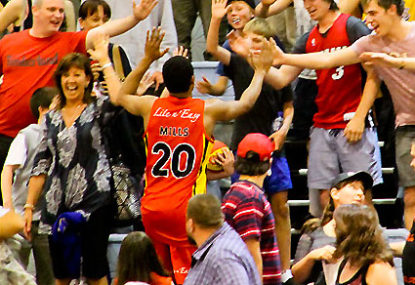If there’s one entity in the NBL system that needs a new name, it’s the NBL itself.
Although last week’s decision to re-brand the Melbourne Tigers as Melbourne United garnered a mixed reaction, the league should follow suit with a re-brand of its own.
The National Basketball League name has been a constant over the years and certainly has a lot of history associated with it. Yet it’s also associated with other things, like having a mountain of teams fold, merge or – sigh – change names.
The brand is hardly a symbol of stability.
Sure, it’s attached to the glory days of the 80s and 90s, but it’s also attached to the decline in interest that followed. Enough time has passed for the latter perception to be more widely held.
Then there’s the fact the NBL of today is struggling to gain momentum on a national scale. Even when there’s massive strides being taken in individual markets – like the Perth Wildcats pulling 10,000+ every game or the signing of NBA-drafted players – it only has a small ripple effect nationwide.
For example, scenes like this were only barely acknowledged outside NBL or West Australian circles:
When other sports produce something big and beautiful like that, it’s put on a pedestal to be admired. See Western Sydney Wanderers and Wanderland. See Port Adelaide and Adelaide Oval.
No one can claim the NBL deserves equal media attention to those sports – it’s a million miles from deserving that – but when stories like this aren’t cutting through at all, it’s a problem.
Put simply, it just feels like the brand isn’t strong enough to fuel the kind of growth the NBL is after.
Issue number two is that the league is currently known by two different names. In Australia, it’s the NBL. In New Zealand, it’s the ANBL.
While you can pester the Kiwis all you want to call the league by ‘its proper name’, you can’t blame them for differentiating between their own 32-year-old NBL and Australia’s NBL that didn’t have a presence in New Zealand until 2003. Especially when their ‘National Basketball League’ is purely a national league. Ours is best described as a transnational league.
The situation will only become more ridiculous when Wellington inevitably join the competition, which is a big chance of happening as soon as next year.
When that time comes, the ‘ANBL’ voices will be heard more often and the ‘National’ portion of the name will be even less applicable.
Issue number three is that if you’re a sports fan who doesn’t closely follow the NBL and its news, you would have no idea about the exciting new direction it’s going in. A statement needs to be made to the general public that from next year, this will not be the same league anymore.
At least four new teams for 2015-16 is the immediate goal for chief executive Fraser Neill. If you believe Neill’s most recent public comments, five newbies next year (Brisbane, South East Melbourne, Tasmania, Wellington and Canberra) is not unrealistic.
Neill’s end-game though, as revealed on my website earlier this year, is grander than that. He wants to eventually bring the number of teams to 16 and give them a 60-game schedule, with games being played every night of the week.
Some query the business case behind this move, but a quick jotting down of sums would hint that there’s at least some method to the madness.
Previously, to turn a profit a team’s costs had to be surpassed by the revenue gained from 14 home games. In future, they’ll have 30 games from which to draw revenue – and the good news is not all costs are going to double along with the number of games.
Player salaries, one of the top expenses, certainly won’t double – a slight increase is more probable – given the extra games will most likely be replacing training sessions in today’s NBL, time the players are already being paid for.
It’s not that simple, of course. Average crowds will take a hit, though clubs will now require less fans to break even.
But the point is Neill isn’t acting on a whim. There’s a well-intended new business model coming in, and while the specifics aren’t perfectly clear, the simple fact the NBL has a CEO talking about five expansion teams – after the task of just one new team in the country’s third-biggest city eluded his predecessors – provides all you really need to know.
The future is bright. The product is set for a drastic overhaul, seemingly for the better. The only problem is who – other than the NBL community – knows about it? These exciting new developments haven’t yet been communicated to the wider public at all.
A new name, if introduced properly, would draw attention to what’s going on and create the fresh buzz – or at least curiosity – that other recently re-launched sporting leagues have seen in their debut seasons.
So what do you change the name to?
Well, call it the Trans Tasman League if you like. This acknowledges who the league truly represents and the audience it’s targeting. It’s simple and easily shortened. It’s not as difficult to wrap your head around as Big Bash League, either.
If that idea isn’t up to scratch, run a competition to collect fan suggestions. Or at the very least, listen to the public by avoiding the marketing firm that brought us Melbourne United.
It’s time, NBL. Pull the trigger.
To better facilitate growth, to bring about consistency and to launch the new era professional basketball is about to enter, the NBL name has to go.





























































































